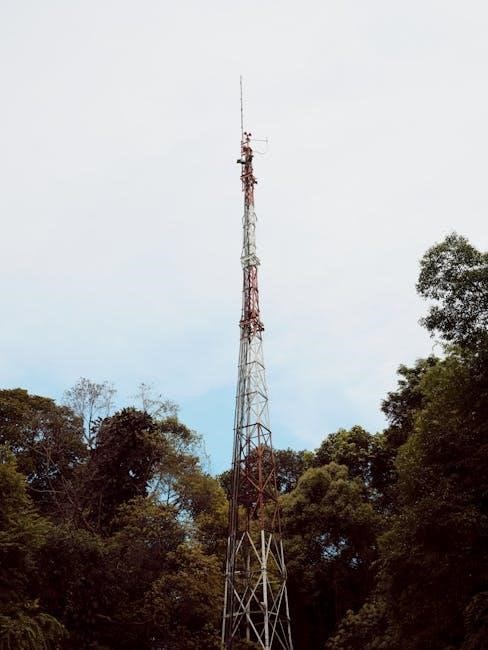The ODOT Signal Detector Manual provides a comprehensive guide for designing, installing, and maintaining traffic signal detectors in Oregon. It outlines standards, regulations, and best practices to ensure safety and efficiency in traffic management systems.
1.1 Overview of the ODOT Signal Detector Manual
The ODOT Signal Detector Manual is a comprehensive guide outlining standards and practices for traffic signal detectors in Oregon. It covers design, installation, and maintenance, ensuring compliance with MUTCD guidelines. The manual provides detailed procedures for detector placement, wiring, and operation, focusing on safety and efficiency in traffic management. It serves as a crucial resource for engineers and technicians, offering clear directives to optimize traffic signal systems statewide.
1.2 Purpose and Scope of the Manual
The ODOT Signal Detector Manual aims to establish uniform standards for traffic signal detectors, ensuring safe and efficient traffic flow. Its scope includes design criteria, installation guidelines, and maintenance protocols, tailored for Oregon’s transportation infrastructure. The manual addresses detector types, placement strategies, and compliance with federal regulations, such as MUTCD guidelines. It serves as a primary reference for engineers, technicians, and contractors involved in traffic signal projects, promoting consistency and adherence to best practices across the state.

Traffic Signal Warrants
This section outlines the criteria for traffic signal installations, focusing on traffic volume, safety, and pedestrian demand. It ensures compliance with MUTCD guidelines for effective traffic management.
2.1 Criteria for New Signal Installations
New traffic signal installations require meeting specific criteria, including traffic volume, accident history, and pedestrian demand. The ODOT manual outlines thresholds for average daily traffic volumes and peak-hour volumes to justify new signals. Additionally, the presence of significant pedestrian activity or unique traffic conditions, such as school crossings, is considered. The Transportation Planning and Analysis Unit (TPAU) provides procedures to evaluate these factors. The Pedestrian Hybrid Beacon (PHB) Evaluation Matrix and Figure 4F-1 or 4F-2 from the OMUTCD are referenced to determine the appropriateness of signal installations. These criteria ensure safety and efficiency in traffic flow management.
2.2 Average Daily Traffic Volumes
Average daily traffic volumes are a critical factor in determining the need for new traffic signals; The ODOT Signal Detector Manual specifies thresholds for mainline and side street volumes to justify signal installations. These volumes are typically measured over peak hours and compared against established warrants. The Transportation Planning and Analysis Unit (TPAU) provides procedures for assessing traffic data, ensuring accurate evaluations. By analyzing these volumes, engineers can identify intersections where traffic signals are necessary to improve safety and reduce congestion, aligning with ODOT’s goal of efficient traffic management. This data-driven approach ensures that signals are installed where they are most needed.
2.3 Future Need Determination
Future need determination involves assessing whether a traffic signal will be required at an intersection based on projected traffic growth and development. The ODOT Signal Detector Manual outlines procedures for evaluating future traffic conditions, incorporating data from traffic studies, land-use plans, and demographic projections. The Transportation Planning and Analysis Unit (TPAU) provides methodologies to forecast traffic volumes and determine if a signal will be necessary within a specific timeframe. This proactive approach ensures that infrastructure plans align with community growth, maintaining safety and efficiency. Public input and long-term development goals are also considered to prioritize future signal installations effectively.

Signal Design Process
The signal design process involves a systematic approach to planning, designing, and approving traffic signals, ensuring compliance with ODOT standards and MUTCD guidelines for safety and efficiency.
3.1 Traffic Signal Design Approval Process
The traffic signal design approval process ensures compliance with ODOT standards and MUTCD guidelines. It begins with an initial review of the design plan, followed by submission to the appropriate authorities for evaluation. Stakeholders, including engineers and traffic experts, verify the design’s safety, efficiency, and adherence to regulations.
Once approved, the design is implemented, with ongoing monitoring to ensure proper functionality. Any modifications require re-submission for approval. This structured process guarantees that traffic signals operate safely and effectively, minimizing conflicts and enhancing overall traffic flow.
The final inspection and operational testing are conducted to confirm compliance before the signal is fully activated.
3.2 Starting the Design
Starting the design involves gathering essential data, including traffic volumes, pedestrian activity, and future projections. Engineers analyze crash history and road geometry to identify safety concerns.
The site assessment ensures compliance with ODOT and MUTCD standards, focusing on visibility, signal placement, and detector zones. Initial sketches outline signal phasing, cabinet locations, and wiring plans.
This phase sets the foundation for a safe and efficient traffic flow, ensuring all elements align with regulatory requirements and project goals.
3.3 Signal Plan Requirements
The signal plan must include detailed traffic data, phasing sequences, and timing diagrams.
It should comply with ODOT and MUTCD standards, ensuring visibility and safety.
Drawings must show mast arms, signal heads, detectors, and wiring layouts.
Approvals from relevant authorities are required before implementation.
The plan should reflect site-specific conditions and optimize traffic flow.

Detector Plan
The Detector Plan outlines the installation and configuration of traffic signal detectors, ensuring accurate traffic monitoring and efficient signal operation. It includes radar, video, and inductive loop detectors, specifying placement, wiring, and connectivity standards to maintain reliable traffic flow and safety.
4.1 Radar/Video Detection Zones
Radar and video detection zones are critical components in traffic signal systems, ensuring accurate vehicle detection and reliable signal operation. These zones are typically illustrated on the signal plan sheet, showcasing the detector unit, conduit, and wiring. The setup is configured by the region signal timer, who defines the coverage areas to optimize traffic flow and safety. Radar/video detection zones are displayed on the cabinet print at the signal timer’s request, ensuring precise monitoring and control of traffic signals. This configuration is essential for maintaining efficient and safe traffic management systems.
4.2 Detector Placement and Coverage Areas
Detector placement is crucial for accurate traffic monitoring and efficient signal operation. Detectors should be positioned to maximize visibility and coverage, ensuring minimal interference from environmental factors. Coverage areas are defined based on the detector type and installation location, with careful consideration of vehicle paths and traffic patterns. Proper placement ensures reliable detection of vehicles, cyclists, and pedestrians, while minimizing false triggers. The region signal timer configures these zones to optimize traffic flow and safety. Detector placement and coverage areas are critical for maintaining the integrity and effectiveness of the traffic signal system.
4.3 Conduit Sizing and Wiring Requirements
Proper conduit sizing and wiring are essential for reliable detector operation. According to ODOT guidelines, conduit must be sized to accommodate all necessary wires, with a maximum fill of 25% to ensure durability, safety, and compliance. Wiring configurations should follow established standards to prevent damage and ensure signal integrity. Detectors, conduit, and wiring must be accurately represented on the signal plan sheet. Adherence to these requirements ensures optimal performance and longevity of the traffic signal system.

Signal Operation and Approval
The operational approval process ensures traffic signals function safely and efficiently. Signal timing and coordination are critical for smooth traffic flow, while conflict monitoring enhances safety and compliance.
5.1 Operational Approval Process
The operational approval process ensures traffic signals meet safety and efficiency standards. It involves preliminary reviews, field inspections, and final approvals by authorized personnel. Documentation must detail compliance with MUTCD guidelines, traffic flow analysis, and safety measures. The process includes verification of signal timing, phasing, and coordination to minimize conflicts and optimize traffic movement. Approval is granted only after all criteria are satisfied, ensuring public safety and operational effectiveness.
5.2 Signal Timing and Coordination
Signal timing and coordination are critical for optimizing traffic flow and reducing congestion. The process involves setting precise intervals for signal phases, ensuring smooth traffic progression along corridors. Coordination synchronizes adjacent signals to maintain consistent traffic movement. Factors like traffic volume, speed, and pedestrian crossings are analyzed to determine optimal timing plans. The Transportation Planning and Analysis Unit (TPAU) provides guidelines for timing adjustments. Advanced detection systems, such as radar and video detectors, help monitor real-time traffic conditions, enabling dynamic adjustments. Proper timing and coordination enhance safety, reduce delays, and improve overall traffic efficiency, aligning with MUTCD standards and regional traffic management goals.
5.3 Conflict Monitoring and Safety Measures
Conflict monitoring ensures traffic signals operate safely and efficiently by detecting and resolving conflicts between signal phases. Safety measures include regular inspections of signal components and timely resolution of malfunctions. The ODOT Signal Detector Manual emphasizes the use of conflict monitors to identify improper signal operations. These devices alert technicians to potential issues, such as conflicting signals or incorrect phasing, ensuring immediate corrective action. Additionally, fail-safe mechanisms and redundancy in signal controls are implemented to prevent accidents. Regular maintenance and real-time monitoring systems further enhance safety by addressing potential hazards before they escalate, aligning with MUTCD guidelines to minimize risks and improve traffic flow.

Installation and Maintenance
The ODOT Signal Detector Manual outlines installation procedures, including mast arm height adjustments and conduit sizing. Regular maintenance ensures optimal detector performance and traffic signal reliability.
6.1 Mast Arm Height and Clearance Requirements
The ODOT Signal Detector Manual specifies that mast arm height and clearance must adhere to strict standards for safety and visibility. Mast arms should be installed at a minimum height of 17 feet and a maximum of 19 feet above the roadway to ensure proper visibility and safety for all road users. These clearance requirements are designed to prevent obstruction and ensure traffic signals are easily visible. The manual also emphasizes compliance with MUTCD guidelines to maintain uniformity in traffic control devices. Proper installation and maintenance of mast arms are critical to ensure reliable operation of traffic signals and detectors.
6.2 Conduit and Wiring Installation Guidelines
The ODOT Signal Detector Manual provides detailed guidelines for conduit and wiring installations to ensure reliable signal operation. Conduit sizing must not exceed 25% fill capacity, as per the 2016 TEM update, to allow for future upgrades. Wiring configurations should follow standardized practices to minimize signal interference and ensure proper connectivity. Proper grounding and shielding are essential to maintain signal integrity and prevent electromagnetic interference. All installations must comply with MUTCD guidelines and local electrical codes. Regular inspections are required to ensure compliance and longevity of the system. Proper labeling and documentation of wiring are also mandated for ease of maintenance and troubleshooting.
6.3 Maintenance and Inspection Procedures
Regular maintenance and inspections are critical to ensure the longevity and reliability of traffic signal systems. The ODOT Signal Detector Manual recommends inspecting detectors, wiring, and conduit connections annually to identify potential issues. Cleaning radar and video detectors is essential to maintain accuracy, while wiring should be checked for damage or degradation. Conduit systems must be inspected for obstructions or water ingress. Signal timing and phasing should be verified during inspections to ensure proper operation. Any malfunctions or discrepancies must be documented and addressed promptly. Routine maintenance schedules and inspection checklists are provided in the manual to streamline the process and ensure compliance with safety standards.

Interconnect and Utilities Plan
The Interconnect and Utilities Plan outlines procedures for coordinating with utility companies, mapping existing infrastructure, and integrating signal systems with current utilities to ensure seamless connectivity and compliance with ODOT standards.
7.1 Interconnect Plan Requirements
The Interconnect Plan Requirements section details the necessary steps for integrating traffic signals with existing infrastructure. It includes guidelines for signal interconnect wiring, configuration, and communication protocols to ensure compatibility and coordination between signals. The plan must adhere to ODOT standards, outlining specific wiring diagrams, conduit sizing, and connectivity protocols. Additionally, it covers procedures for testing and verifying interconnect systems to ensure reliable operation; Compliance with these requirements is essential to maintain traffic flow efficiency and safety across interconnected signal systems.
7.2 Existing Utilities Plan
The Existing Utilities Plan section outlines the process for identifying and mapping all existing underground and overhead utilities near traffic signal installations. This includes power lines, communication cables, water mains, and sewer lines. The plan ensures that new signal installations do not conflict with existing infrastructure, minimizing disruptions and potential safety hazards. It requires coordination with utility providers to verify locations and ensure compliance with ODOT standards. Detailed diagrams and documentation are necessary to guide installation teams effectively. This step is crucial for maintaining public safety and system reliability during construction and operation.
7.3 Signal Interconnect Wiring and Configuration
Signal Interconnect Wiring and Configuration ensures proper communication between traffic signals and connected devices. This section details the wiring standards, connectors, and configuration protocols for interconnecting traffic signals, detectors, and controllers. It emphasizes the importance of proper wiring to prevent signal conflicts and ensure reliable operation. The manual provides guidelines for wiring diagrams, cable sizing, and termination procedures. Configuration parameters, such as timing settings and phase sequences, are also outlined to maintain consistency across interconnected systems. Compliance with ODOT standards is critical to ensure safety and efficiency in traffic signal networks.

Temporary and Removal Plans
This section outlines procedures for temporary signal installations and removal plans, ensuring safe and efficient traffic management during construction or maintenance activities while complying with ODOT standards.
8.1 Temporary Signal Installation
Temporary signal installations are essential for maintaining traffic flow during construction or maintenance. The ODOT Signal Detector Manual specifies that temporary signals must be installed according to approved plans, ensuring safety and visibility. Portable signals or battery-operated devices are commonly used, with retroreflective signs placed at intersections. Timing and phasing must align with existing traffic patterns to minimize disruptions. Radar or video detectors may be employed for real-time monitoring. Compliance with MUTCD guidelines is mandatory, and all installations must be inspected before activation. Temporary signals are removed once permanent systems are operational, following strict removal protocols to restore original traffic conditions.
8.2 Removal Plan Requirements
The removal of temporary signals must adhere to ODOT guidelines to ensure safety and restore original traffic conditions. All equipment, including detectors, conduits, and wiring, must be deactivated and removed promptly; Restoration of the site to pre-installation conditions is required, including repaving or repairing any excavated areas. Disposal of materials must follow environmental regulations. Coordination with local authorities is essential to minimize disruptions. Proper documentation of removal activities is mandatory for record-keeping. The removal plan must be approved by ODOT before execution, ensuring compliance with safety and operational standards throughout the process.
8.3 Temporary Signal Timing and Phasing
Temporary signal timing and phasing must align with existing traffic patterns to maintain safety and efficiency. Timing plans should be pre-approved by ODOT and coordinated with permanent signals. Phase sequences must prioritize pedestrian safety and minimize disruptions. Real-time monitoring is required to ensure proper operation and address conflicts. Adjustments should be documented and approved to maintain compliance. Temporary signals must adhere to MUTCD guidelines and local regulations. Proper timing ensures smooth traffic flow and reduces congestion during construction or maintenance activities. The phasing plan should be clearly outlined in the temporary signal plan and reviewed by ODOT before implementation.

Safety and Compliance
The ODOT Signal Detector Manual ensures adherence to MUTCD guidelines, emphasizing safety measures and regulatory compliance. Regular inspections and documentation are required to prevent accidents and ensure system reliability.
9.1 Safety Precautions and Standards
The ODOT Signal Detector Manual emphasizes strict adherence to safety protocols and industry standards. It outlines procedures for ensuring the safe installation and maintenance of traffic signal detectors, including proper use of personal protective equipment and adherence to MUTCD guidelines; Engineers must follow established conflict monitoring standards to prevent signal malfunctions. Regular inspections are required to identify and address potential hazards. Compliance with federal and state regulations is mandatory to ensure public safety and system reliability. The manual also provides detailed instructions for handling electrical components and avoiding risks associated with signal operation.
9.2 Compliance with MUTCD Guidelines
The ODOT Signal Detector Manual requires strict compliance with the Manual on Uniform Traffic Control Devices (MUTCD) guidelines, ensuring consistency and safety in traffic signal design. Adherence to MUTCD standards is mandatory for all signal installations, including detector placement and operation. The manual references specific MUTCD chapters, such as Chapter 4F, which outlines traffic signal operations and control. Engineers must follow these guidelines to ensure uniformity and compliance with federal and state regulations. Failure to comply may result in legal and safety issues, emphasizing the importance of staying updated with MUTCD revisions and requirements.
9.3 Conflict Monitoring and Resolution
The ODOT Signal Detector Manual emphasizes the importance of conflict monitoring to identify and resolve signal-related issues promptly. Conflict monitors are devices or systems used to detect improper or conflicting signal operations, ensuring safe and efficient traffic flow. The manual outlines procedures for monitoring signal conflicts, such as incorrect signal phases or timing mismatches. Resolution involves diagnosing the root cause and implementing corrective actions, which may include software updates, hardware repairs, or adjustments to signal timing. Regular inspections and real-time monitoring systems are recommended to proactively address potential conflicts. Proper documentation and reporting of conflicts are also required to maintain accountability and improve future signal designs.

References and Resources
The ODOT Traffic Signal Design Manual and MUTCD Chapter 4F provide essential guidelines. Additional resources include the Analysis Procedures Manual and ODOT’s drawing archive for approved traffic plans.
10.1 ODOT Traffic Signal Design Manual
The ODOT Traffic Signal Design Manual is a primary resource for traffic signal design and installation in Oregon. It provides detailed guidelines on signal warrants, design approval processes, and operational requirements. The manual is regularly updated to reflect current standards and practices. Engineers and technicians rely on this document for comprehensive information on traffic signal systems, including detector placement, timing coordination, and safety measures. It is available online and serves as a foundational reference for ensuring compliance with state and federal regulations. This manual is essential for anyone involved in traffic signal projects within Oregon.
10.2 MUTCD Chapter 4F Guidelines
MUTCD Chapter 4F provides federal guidelines for traffic signal control, complementing the ODOT Signal Detector Manual. This chapter outlines standards for traffic signal installation, operation, and maintenance, ensuring uniformity nationwide. It covers topics like signal phasing, timing, and coordination, as well as requirements for radar and video detection systems. Engineers must adhere to these guidelines to ensure compliance with federal regulations. The chapter also addresses safety measures and best practices for signal design, making it a critical resource for traffic engineers working on signal systems in Oregon and across the U.S. Proper implementation of these guidelines ensures efficient and safe traffic flow.
10.3 Additional Resources and Guides
Beyond the ODOT Signal Detector Manual, several supplementary resources are available to support traffic signal design and installation. The ODOT Traffic Signal Design Manual provides detailed design standards, while the MUTCD offers federal guidelines for traffic control devices. The Analysis Procedure Manual (APM) and Traffic Signal Timing Manual (TSTM) further assist in operational and timing aspects. Engineers can also access approved traffic plans and illumination guides through ODOT’s drawing archive. These resources ensure compliance with both state and federal regulations, offering comprehensive support for traffic signal projects. Additional guides, such as the Pedestrian Hybrid Evaluation Matrix, aid in specialized installations, ensuring safety and efficiency in traffic management systems;
